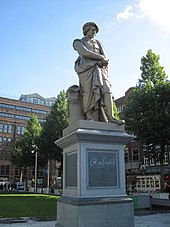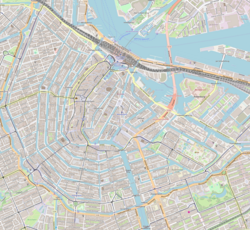
Nelson's Column is a monument in Trafalgar Square in the City of Westminster, Central London, built to commemorate Vice-Admiral Horatio Nelson's decisive victory at the Battle of Trafalgar over the combined French and Spanish navies, during which he lost his life. The monument was constructed between 1840 and 1843 to a design by William Railton at a cost of £47,000. It is a column of the Corinthian order built from Dartmoor granite. The statue of Nelson was carved from Craigleith sandstone by sculptor Edward Hodges Baily. The four bronze lions around its base, designed by Sir Edwin Landseer, were added in 1867.

Sir Jacob Epstein was an American-British sculptor who helped pioneer modern sculpture. He was born in the United States, and moved to Europe in 1902, becoming a British subject in 1910.

ABN AMRO Bank N.V. is the third-largest Dutch bank, with headquarters in Amsterdam. It was initially formed in 1991 by merger of the two prior Dutch banks that form its name, Algemene Bank Nederland (ABN) and Amsterdamsche en Rotterdamsche Bank.

Militia Company of District II under the Command of Captain Frans Banninck Cocq, also known as The Shooting Company of Frans Banning Cocq and Willem van Ruytenburch, but commonly referred to as The Night Watch, is a 1642 painting by Rembrandt van Rijn. It is in the collection of the Amsterdam Museum but is prominently displayed in the Rijksmuseum as the best-known painting in its collection. The Night Watch is one of the most famous Dutch Golden Age paintings. Rembrandt's large painting is famed for transforming a group portrait of a civic guard company into a compelling drama energized by light and shadow (tenebrism). The title is a misnomer; the painting does not depict a nocturnal scene.
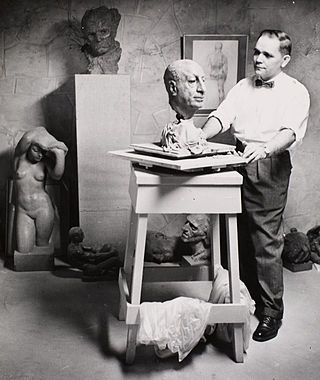
Leonid Molodozhanyn, known as Leo Mol, was a Ukrainian Canadian stained glass artist, painter and sculptor.
Hundreds of replicas of the Statue of Liberty have been created worldwide. The original Statue of Liberty, designed by sculptor Frédéric Auguste Bartholdi, is 151 feet tall and stands on a pedestal that is 154 feet tall, making the height of the entire sculpture 305 feet.

Louis Royer, also Lodewyk Royer, was a Flemish sculptor who worked in the Netherlands where he received many commissions from the royal family and for public statues.
Abdul Rahman Mowakket is a contemporary sculptor from Syria.
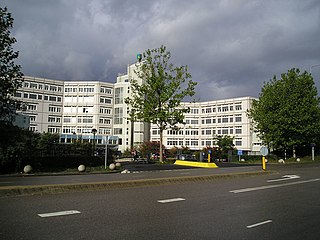
The AMsterdamsche en ROtterdamsche Bank was a major Dutch bank that was created in 1964 by the merger of the Amsterdamsche Bank and the Rotterdamsche Bank. In 1991, it merged with Algemene Bank Nederland (ABN) to form ABN AMRO.

Vandalism of art is intentional damage of an artwork. The object, usually exhibited in public, becomes damaged as a result of the act, and remains in place right after the act. This may distinguish it from art destruction and iconoclasm, where it may be wholly destroyed and removed, and art theft, or looting.
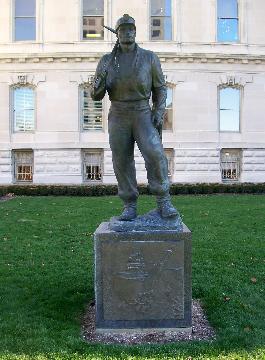
Coal Miner is a public artwork by Polish American artist John J. Szaton (1907–1966) which is located in two US State capitals; the original, commissioned in 1963 in Springfield, Illinois, as well as a copy on the west lawn of the Indiana State House in Indianapolis The statues commemorate coal miners who had lost their lives in those states' mining industry. The 7-foot (2.1 m) tall statue rests on a 3-foot (0.91 m) square, granite base supported by a cement foundation that is 4–6 inches (100–150 mm) thick.

The Davis Square statues, entitled Ten Figures, are life-sized cast concrete public sculpture, created by James Tyler, located in Davis Square, Somerville, Massachusetts at or near the Davis, Massachusetts Bay Transportation Authority subway station. The statues are mostly based on people who lived near Davis Square in the 1980s. In 1996 bronze "masks" were added to the sculptures to repair damage and deter future vandalism.
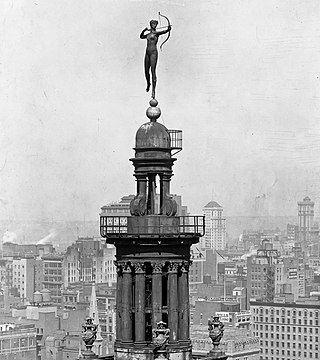
Diana – also known as Diana of the Tower – is an iconic statue by sculptor Augustus Saint-Gaudens, representing the goddess Diana. Once a major artistic feature of New York City, the second version stood atop the tower of Madison Square Garden from 1893 to 1925. Since 1932, it has been in the collection of the Philadelphia Museum of Art.
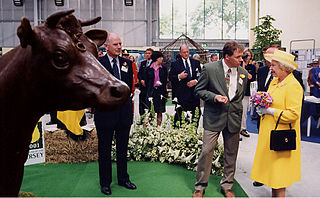
John McKenna is a Scottish sculptor born in Manchester. He is based in Turnberry, South Ayrshire, Scotland.

Nicholas Legeros is an American (Minnesotan) bronze sculptor. Working from his studio building Blue Ribbon Bronze in Northeast Minneapolis, Nick has created over 500 sculptures in his career. His most prominent works can be found in the Twin Cities and Hudson, Wisconsin. In addition to his work as a sculptor, Nick is an active artist advocate and has been president of the Society of Minnesota Sculptors (1988-1995), president of the Northeast Minneapolis Artists Association (2007-2009), and served on many boards including the Northeast Community Development Corporation.

The Ajax Experience was a museum dedicated to AFC Ajax' club history in Amsterdam in the Netherlands. The museum, located at the Rembrandtplein, was opened on 24 September 2011 and closed within two years after a 9 million euro loss.

A bronze statue of William the Silent was installed in 1928 on the Voorhees Mall section of Rutgers University's College Avenue Campus in New Brunswick, New Jersey. It is along Seminary Place, a street at the western end of the Voorhees Mall, and near several academic buildings, including the university's Graduate School of Education, Van Dyke Hall, and Milledoler Hall.

A bronze statue of Moses by Croatian artist Josip Turkalj installed at the main campus of the University of Notre Dame in South Bend, Indiana, just outside of the Hesburgh Library. Commissioned in 1962, the sculpture is owned by the University of Notre Dame.

Neil Goodman is an American sculptor and educator, known for bronze works that combine elegant arrangements and forms with hand-wrought, textured surfaces. He has explored a wide range of formats—still-life compositions, wall and floor installations, free-standing works and monumental public art—in a formalist style that has evolved from spare representation to abstraction and minimalism.

